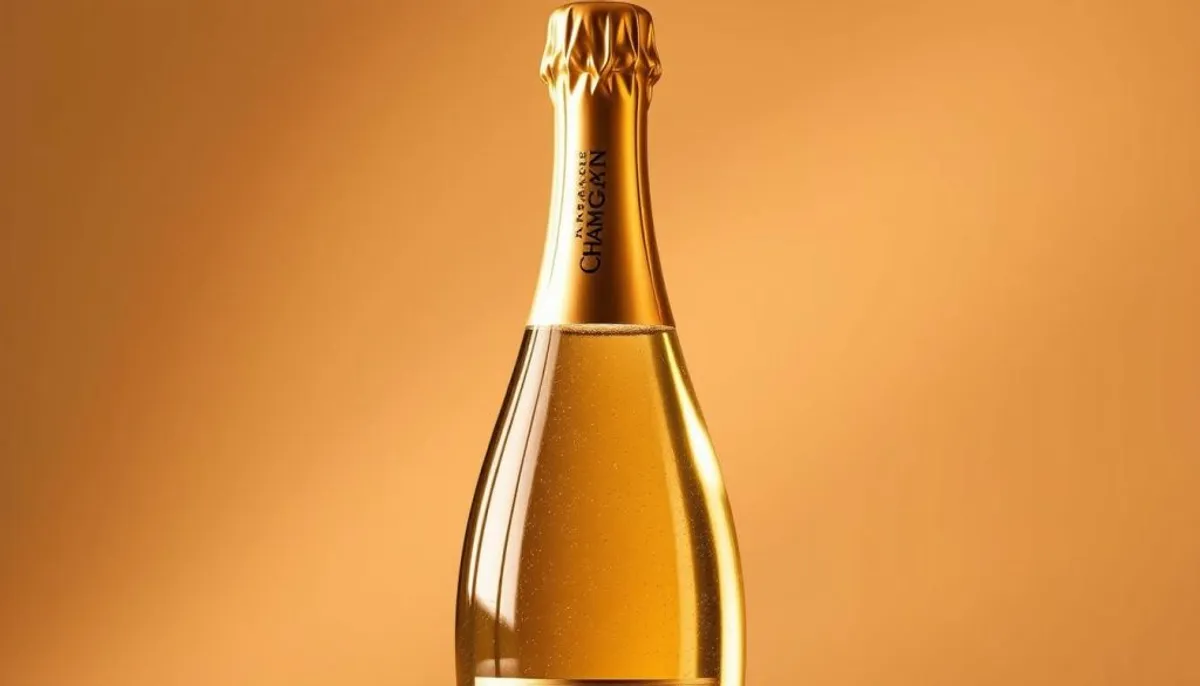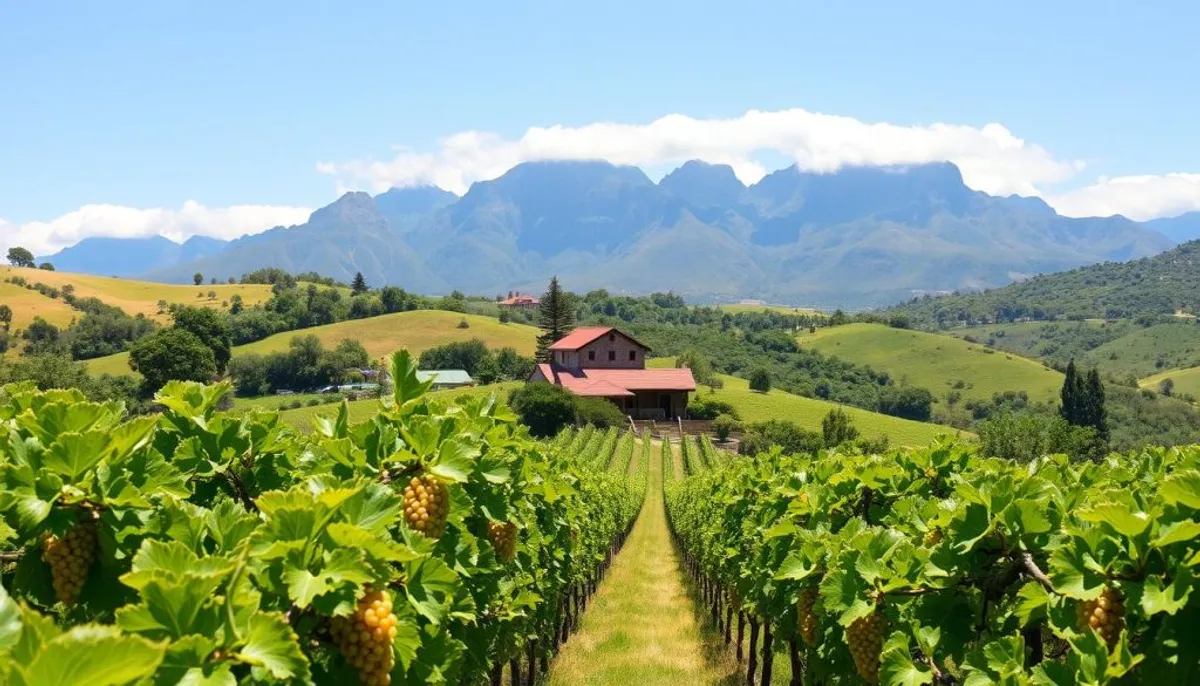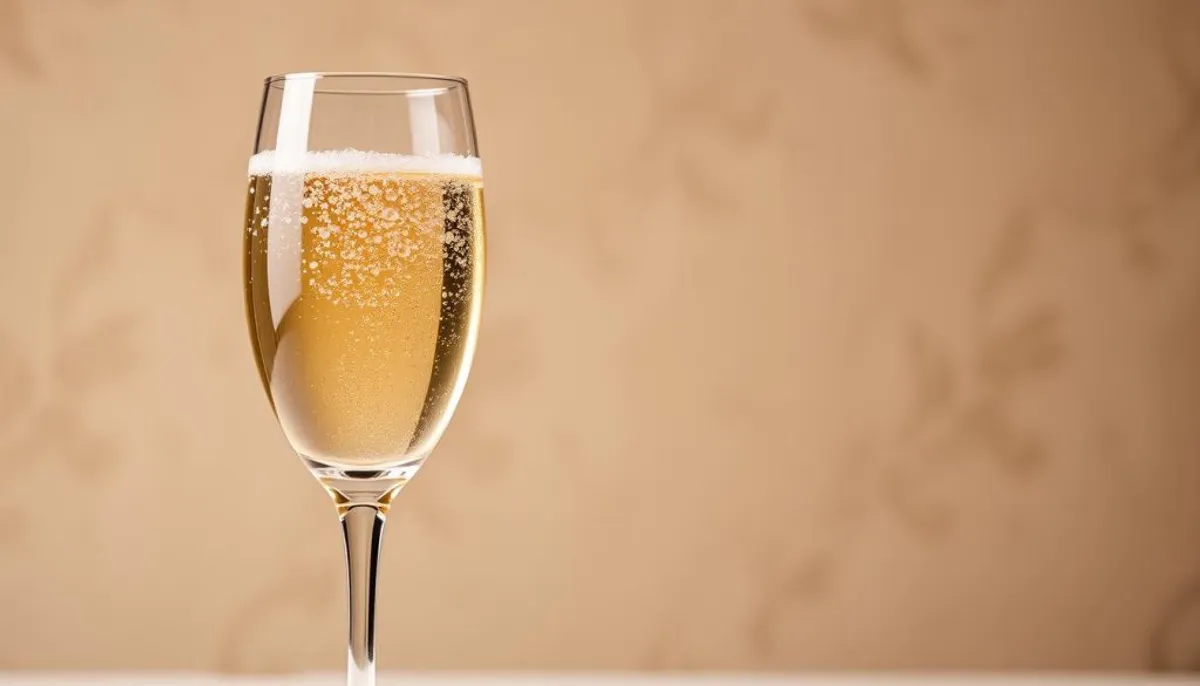Seeking Champagne? We’ve got you covered. Champagne MCC, a sparkling wine that rivals its French counterpart, is ready to be exported worldwide. This South African gem, known as Cap Classique, employs the traditional Méthode Champenoise to create bubbles that dance on your tongue.
While true Champagne originates exclusively from France’s Champagne region, South Africa’s MCCs offer a delightful alternative. These wines utilize the same meticulous production methods and grape varieties as their French cousins. The result is a sparkling wine that has earned its place among the world’s finest.

Cap Classique has been turning heads since its introduction in 1971. In fact, a South African MCC brut once outshone renowned brands like Dom Pérignon and Cristal in a blind taste test. With over 250 producers crafting these exquisite wines today, there’s a world of flavors to explore.
Key Takeaways
- Champagne MCC is South Africa’s answer to French sparkling wine
- Cap Classique uses the traditional Méthode Champenoise
- MCC wines have won international acclaim
- Over 250 producers create Cap Classique in South Africa
- MCCs offer a range of styles from brut to demi-sec
- Cap Classique Day is celebrated on September 1st annually
Understanding Méthode Champenoise: The Traditional Method
The méthode champenoise stands as the cornerstone of luxury bubbly creation, a meticulous art form that elevates still wine into sparkling splendor. This traditional technique, celebrated by UNESCO in 2015, is the essence behind the effervescence we cherish in premium sparkling wines.
Primary Fermentation Process
The journey commences with primary fermentation, where grapes undergo pressing, and the juice ferments into a base wine. This foundational step is pivotal in shaping the sparkling wine’s character and complexity.
Secondary Bottle Fermentation
The essence of méthode champenoise is revealed in the secondary fermentation. The base wine is combined with sugar and yeast, initiating fermentation within the bottle. This intricate process generates the wine’s signature bubbles and increases its alcohol content by about 1.3%. The resulting pressure, reaching 5-7 atmospheres, surpasses that of other sparkling wine methods.
Aging on Lees and Riddling
Post-secondary fermentation, the wine ages on lees for 15 to 36 months, enriching its flavors. Riddling ensues, where bottles are turned daily at a 45° angle to concentrate sediment in the neck. The final step, disgorgement, involves freezing the neck to expel the sediment, followed by corking.
This labor-intensive approach yields a luxury bubbly of unmatched complexity and elegance. One such example is the andre clouet brut, which showcases the finesse of this method. While Champagne often exceeds R500, Méthode Cap Classique (MCC) offers comparable quality at around R200, presenting a remarkable value for those who appreciate sparkling wines.
The Origins and History of Cap Classique
Cap Classique, South Africa’s response to French sparkling wine, began in the late 1960s. It is a testament to the innovative winemakers who merged French methods with their local terroir. This adaptation created a unique champagne mcc equivalent.
In 1971, Frans Malan of Simonsig Wine Estate in Stellenbosch began harvesting Chenin Blanc grapes. This marked the beginning of Cap Classique. Two years later, in 1973, Simonsig introduced “Kaapse Vonkel,” the first sparkling wine of its kind.
The term “Methode Cap Classique” (MCC) was formally adopted in 1992. This distinction set these wines apart from others. Today, Cap Classique stands on par with French sparkling wines, with 250 producers creating 10 million bottles each year in the Cape winelands.
| Aspect | Cap Classique | French Sparkling Wine |
|---|---|---|
| Minimum aging period | 15 months | 3 years (vintage Champagne) |
| Main grape varieties | Chardonnay, Pinot Noir, Pinot Meunier | Chardonnay, Pinot Noir, Pinot Meunier |
| Average price range (in South Africa) | R170 – R200 | R650 – R10,000 |
As Cap Classique celebrates its 50th anniversary in 2023, it continues to evolve. It offers a range of styles, from Blanc de Blancs to rosé, with lees contact varying from 12 to over 60 months. This category, inspired by French sparkling wines, has gained international acclaim. For those interested in exploring this fascinating world, a wine enthusiast guide can provide valuable insights. It exports 27% of its production to countries like the UK, USA, and Germany.
Premier Regions for Champagne MCC Production
South Africa is home to several exceptional regions for Méthode Cap Classique (MCC) wine production. These areas rival the quality of grand cru champagne. They offer unique terroirs that contribute to the creation of premier cru champagne-style sparkling wines, including exquisite california sparkling wine.
Robertson Valley’s Limestone Terroir
Renowned as the “Valley of Wine and Roses,” Robertson Valley is distinguished by its limestone-rich soils. This terroir imparts a distinct minerality to MCC wines, akin to the finest grand cru champagne. The region’s climate and soil composition are ideal for growing Chardonnay and Pinot Noir, the primary grapes in MCC production.
Stellenbosch’s Historic Vineyards
Stellenbosch, with its centuries-old winemaking tradition, is home to some of South Africa’s most prestigious MCCs. The region’s diverse microclimates and well-drained soils contribute to the complexity and depth of flavors in their sparkling wines. Stellenbosch MCCs often exhibit a balance of fruit and acidity comparable to premier cru champagne.

Hemel-en-Aarde Valley Climate
The Hemel-en-Aarde Valley’s cool climate allows for slow grape ripening, resulting in MCCs with delicate flavors and pronounced acidity. This region’s clay-rich soils and maritime influence create conditions similar to those found in premier cru champagne areas. The sparkling wines produced here have exceptional finesse and longevity.
| Region | Key Characteristic | Prominent Grape Varieties |
|---|---|---|
| Robertson Valley | Limestone-rich soils | Chardonnay, Pinot Noir |
| Stellenbosch | Diverse microclimates | Chardonnay, Pinot Noir, Chenin Blanc |
| Hemel-en-Aarde Valley | Cool climate, clay-rich soils | Chardonnay, Pinot Noir |
Distinguished Grape Varieties in MCC Production
The realm of Champagne MCC and French sparkling wine is teeming with a variety of grape types, including various champagne varietals. These grapes are the cornerstone of outstanding sparkling wines, each imparting distinct qualities to the final creation.
Classic Champagne Varietals
Chardonnay, Pinot Noir, and Pinot Meunier dominate traditional Champagne production. Chardonnay contributes elegance and refinement, while Pinot Noir enhances the wine’s body and structure. Pinot Meunier, on the other hand, adds fruitiness and aromatic depth to the blend.
South African Indigenous Grapes
South African vintners incorporate local grapes into their MCC production. Chenin Blanc, celebrated for its adaptability, introduces freshness and floral nuances. Pinotage, South Africa’s emblematic red grape, is sometimes employed to create distinctive rosé MCCs.
Unique Varietal Blends
South African winemakers are pioneering the creation of unique blends, combining traditional and local grapes. These innovative combinations yield MCCs that embody the essence of French sparkling wine, infused with a distinctly South African flair.
| Grape Variety | Origin | Contribution to MCC |
|---|---|---|
| Chardonnay | France | Elegance, finesse |
| Pinot Noir | France | Body, structure |
| Chenin Blanc | South Africa | Freshness, floral notes |
| Pinotage | South Africa | Unique rosé character |
Prestige Cuvée Selection Guide
Choosing a prestige cuvée demands insight into what distinguishes these elite sparkling wines. These wines embody the zenith of winemaking, crafted from the most superior grapes and aged extensively. For instance, the Alexandra de la Marque Krone 2010, a South African cuvée de prestige, is a combination of 80% Chardonnay and 20% Pinot Noir, showcasing various champagne varietals. It undergoes bottle fermentation for 5 years before its release.
When selecting a prestige cuvée, consider the following factors:
- Grape selection: Seek wines from top-tier vineyards
- Extended aging: Prestige cuvées typically age longer than standard wines
- Limited production: Many are crafted in small batches, such as Alexandra’s 6000 bottles
- Vintage significance: Some prestige cuvées are only released in outstanding years
Graham Beck, a leading Cap Classique producer, offers prestige cuvées that rival French Champagnes. Their Brut Reserve NV exemplifies South African sparkling wine’s potential. It is a blend of 52% Pinot Noir and 48% Chardonnay, aged for 30 months on lees.
When selecting a prestige cuvée, consider the producer’s heritage, like Krone’s 12 generations of winemaking since 1710. These historical details enrich the wine’s narrative and value, transforming each sip into a unique and memorable experience.
Tasting Profile and Characteristics
Cap Classique wines deliver a sensory journey akin to luxury bubbly from famous regions. These South African sparkling wines combine complexity and elegance, bridging the gap between Champagne and California sparkling wine.
Aroma Components
The nose of a brut champagne-style Cap Classique presents a delightful bouquet. Fruity and floral notes blend with brioche and toasty aromas, a result of extended lees aging. The 2011 Graham Beck Cuvee Clive, aged for 89 months on lees, exemplifies this rich aromatic profile.
Palate Structure
On the palate, Cap Classique wines display a harmonious balance of acidity, fruit, and autolytic flavors. The 2012 Graham Beck Blanc de Blancs, scoring 93/100, demonstrates this equilibrium. With varying sugar levels, from 3.5 g/l in Durbanville Hills to 6.94 g/l in Genevieve Blanc de Blancs, these luxury bubblies cater to diverse taste preferences, including some of the best demi sec wines.
Bubble Quality and Texture
The hallmark of a fine Cap Classique is its effervescence. A delicate mousse contributes to a creamy mouthfeel, enhancing the overall tasting experience. Extended lees contact, ranging from 14 months for Filia Chenin Blanc to 48 months for Cederberg Blanc de Blancs, results in finer bubbles and a silky texture.
| Wine | Lees Aging | Notable Characteristics |
|---|---|---|
| Graham Beck Cuvee Clive 2011 | 89 months | Rich aromatic profile |
| Cederberg Blanc de Blancs 2011 | 48 months | Fine bubbles, silky texture |
| L’Ormarins Blanc de Blancs 2012 | 48 months | 20% barrel fermentation |

Leading Cap Classique Producers
South Africa’s Cap Classique wines stand on par with French sparkling wine in terms of quality and prestige. The Cap Classique Producers Association celebrated a milestone in 2021, marking 50 years of premium production. This achievement underscores half a century of excellence in champagne MCC.
Simonsig Wine Estate Legacy
Simonsig Wine Estate was at the forefront of Cap Classique in 1971 with their Kaapse Vonkel. This pioneering release catalyzed South Africa’s sparkling wine movement. Today, Simonsig continues to excel in Cap Classique production. Their Kaapse Vonkel Brut 2019 exemplifies outstanding value at $15 per bottle.
Graham Beck Excellence
Graham Beck is a colossus in Cap Classique production. Their Brut NV, first introduced in 1991, has become the UK’s best-selling Cap Classique. Graham Beck’s range is characterized by consistent quality, from the $20 Brut Rosé NV to the prestigious $73 Cuvée Clive.
Boutique MCC Houses
Smaller producers are innovating in Cap Classique creation. Steenberg’s 1682 Chardonnay Brut and Villiera’s Tradition Brut NV offer exceptional quality at $15 and $21 respectively. Boutique houses like Colmant and Le Lude produce limited quantities of high-end sparkling wines. These rival French champagne in quality.
| Producer | Wine | ABV | Price (750ml) |
|---|---|---|---|
| Graham Beck | Ultra Brut | 12% | $31 |
| Simonsig | Kaapse Vonkel Brut 2019 | 12% | $15 |
| Boschendal | Grande Cuvée Brut 2015 | 12.5% | $36 |
| Villiera | Tradition Brut NV | 12% | $21 |
Food Pairing and Serving Suggestions
Champagne MCC and luxury bubbly present a myriad of pairing options across diverse cuisines. Brut Cap Classique, with its sharp acidity, pairs exquisitely with oysters, achieving a harmonious balance of flavors. For aficionados of sushi, a rosé sparkling wine beautifully complements the refined tastes of tuna sashimi and California rolls, while a glass of California sparkling wine can enhance the overall dining experience.
In South Africa, a Demi-Sec sparkling wine significantly enhances the sweetness of Melktert, a classic custard dessert. Blanc de Blancs, crafted from Chardonnay grapes, excels when paired with fresh goat’s cheese salads, notably those featuring roasted beetroot and green apples.
For those desiring robust flavors, pairing a Pinot Noir-based sparkling wine with biltong is recommended. The wine’s rich fruit notes contrast magnificently with the dried meat’s texture. Cuvée sparkling wines, often a blend of various grape varieties, pair exceptionally well with grilled prawns, their citrus notes enhancing the smoky flavors.
When serving Champagne MCC, it’s crucial to match the wine’s intensity with the dish. Robust wines are best paired with flavorful dishes, while lighter wines complement delicate bites. The acidity in sparkling wines should harmonize with citrusy or vinegary notes in food for an enhanced tasting experience.
To maximize enjoyment, serve your luxury bubbly at the correct temperature and in suitable glassware. This attention to detail will enhance your Champagne MCC experience, whether you’re hosting a special celebration or simply savoring a moment of everyday luxury.
Investment and Collecting Vintage MCCs
Vintage champagne aficionados are increasingly focusing on Méthode Cap Classique (MCC) wines from South Africa. These sparkling wines are gaining traction as an investment opportunity, rivaling the prestige of France’s grand cru champagne. We will dive into the allure of collecting vintage MCCs and their potential for value growth.
Aging Potential
MCCs exhibit an impressive aging potential. The 2009 Blanc de Blanc MCC from Quoin Rock, for instance, aged on lees for nine years before being disgorged. This prolonged aging period significantly enhances their complexity and flavor, making them highly coveted by collectors. Additionally, the rise of california sparkling wine has contributed to the diversity and richness of options available to enthusiasts.
Storage Requirements
Ensuring the quality of MCCs requires proper storage. It is essential to store bottles:
- In a cool, dark place
- At a constant temperature between 10-15°C
- Away from vibrations
- Horizontally to keep corks moist
Value Appreciation
The value of MCCs is influenced by several factors, including rarity, the reputation of the producer, and critical acclaim. Graham Beck’s Cuvée Clive 2007, priced at R480, spent 60 months on lees. Its extended aging and limited production contribute to its value. Collectors should be aware that MCCs from renowned producers like Graham Beck and Quoin Rock have garnered high ratings, signaling potential for appreciation.
| MCC | Lees Aging | Price (R) |
|---|---|---|
| Graham Beck Brut NV | 18 months | 105 |
| Graham Beck Vintage Rosé | 36 months | 205 |
| Graham Beck Cuvée Clive | 60 months | 480 |
Global Recognition and Awards
Champagne MCC has achieved global acclaim, outshining premier cru champagne in renowned competitions. South African sparkling wines have garnered numerous accolades, solidifying their position in the luxury wine market. For those looking to deepen their understanding, a wine enthusiast guide can provide valuable insights into these exceptional wines.
The 2023 South Africa Special Report by Tim Atkin highlights the exceptional quality of Cap Classique wines. Over 70% of the 121 Cap Classiques tasted received scores exceeding 90 points, demonstrating their world-class status. The report, spanning 317 pages, showcases the remarkable growth and diversity within the sector.
Graham Beck, a leading Champagne MCC producer, achieved outstanding recognition. Their 2018 Cuvée Clive was crowned Overall Sparkling Wine Of The Year, scoring an impressive 97 points. The 2009 Graham Beck Artisan Collection Extra Brut 157 earned 96 points and the title of Sparkling Wine Discovery of the Year.
Other notable achievements include Silverthorn’s Jewel Box MCC 2018 and Le Lude Venus Brut Nature MCC 2014, both scoring 95 points or higher. These accolades underscore the growing complexity and quality of South African sparkling wines, rivaling esteemed champagne houses.
The global recognition of Champagne MCC is further evidenced by the 12% annual growth in sales. This surge in popularity reflects the increasing appreciation for these exceptional sparkling wines on the international stage.
Conclusion
Champagne MCC has distinguished itself in the sparkling wine realm. South African winemakers, with over 25 years of experience in the Method Cap Classique, have perfected the art of creating bubbles. Their work rivals that of French sparkling wine, adhering to the Appellation of Origin system’s strict standards.
The journey of MCC in South Africa began in the 1970s. Today, over 80 wineries, including boutique wineries, produce Cap Classique, showcasing the growth of the sparkling wine industry. The blend of classic varietals like Chardonnay and Pinot Noir with local grapes offers a wide range of styles. This diversity caters to every taste, from the crisp Blanc de Blancs to the robust Blanc de Noirs.
Champagne MCC’s global acclaim is evident in its presence at prestigious events and its success in international competitions. Its versatility in food pairing, from oysters to cheese, has made it a favorite among wine enthusiasts. For those seeking quality bubbly at an attractive price, South African sparkling wines provide exceptional value.
Ready to explore the world of Champagne MCC? Visit https://champagne-export.com to request your personalized quote. Bring the luxury of South African sparkling wine to your doorstep. Discover why these wines are becoming some of the most sought-after bubblies globally.
RelatedRelated articles



